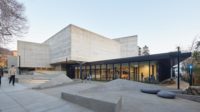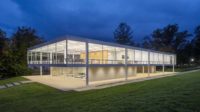Restoration Redux
Top architects are tackling historic buildings in surprising ways.
Preservation has returned to the center of architectural theory and practice, after languishing in the margins for over half a century. Just a decade ago, it would have been impossible to think that the stakes of the field would be set by projects like David Chipperfield and Julian Harrap's restoration of the Neues Museum in Berlin, Diller Scofidio + Renfro's subtle morphing of Lincoln Center and the High Line in New York, Rem Koolhaas's forensic preservation of the Hermitage in St. Petersburg, or Herzog & de Meuron's adaptation of the Park Avenue Armory in New York. Back then, such figures rarely involved themselves in preservation'not simply because they had defined their careers through new construction, but because they saw it as rather unimaginative work. Now these architects approach preservation projects with anxious care. It is as if preservation were the hardest move, the piked double Arabian with full twist, of architectural gymnastics. If so, then a profound reordering of the criteria for judging architectural excellence is taking place.
What makes the Neues Museum shocking is the level of restraint the architects demonstrated, at a time when it was common to hire world-class designers precisely to intimidate preservation commissions into allowing egregious 'adaptations' of historic buildings into contemporary 'icons.' Against the grain of the grand gesture, Chipperfield and Harrap opted for the precision of discreet interventions. Their design consisted mostly of removing historically insignificant elements. When they did add, they did so to enhance what was there, as one adds salt to bring out the flavor of a dish instead of covering it with sauce. For instance, they added subtle tints to the lacunae in decorative patterns to reintegrate the losses into a complete image. Even the most emphatically new elements, like the grand staircase, echo the form of the lost original.
This echoing approach to situating architecture is a key departure from previous models. An echo is by definition not a facsimile of the original voice, and therefore not a 'restoration' in the traditional sense. It is the return of that voice from the future, transformed by the time that separates it from the original. An echo cannot return the original in its pure form. It returns a cleft original, bearing the dividing mark of a split temporality that cannot be easily located as part of the present. The Neues Museum was brought back deceptively intact, but in fact profoundly changed.
Prior to the High Line, 'adaptive reuse' was invariably understood to mean the process whereby an old building suffered changes for the satisfaction of new uses according to a fixed logic of contemporary architecture. With the High Line, the meaning of the term began to shift to signify the mutual adaptation of contemporary architecture and old buildings to each other. The shift is subtle but important because it implies a revision of one of our discipline's foundational ideas: that contemporary architecture comes into existence through its confrontation with building. We had taken it as a given that the word 'building' stood for new construction. Now it is clear that contemporary architecture can also emerge by adapting an old construction. The old criterion that new architecture was only possible through a new building is dead.
Koolhaas's master plan to update the Hermitage Museum, in time for its 250th anniversary in 2014, is another example of producing contemporary architecture through (as opposed to next to, or on top of) old buildings. Koolhaas claims to avoid 'declarative architectural interventions,' and turns to preservation for a new form of expression. His strategy is to forensically retain all traces of the old buildings, even the dusty showcases, but to relocate every object, leaving some rooms empty in anticipation of what the future may bring. So he expresses contemporary architecture as an ephemeral process more than a permanent object, a way of opening (old) buildings to new meanings. The Hermitage signals another important new direction, away from the past as history and toward questions of temporality. In the wake of Postmodernism, we are more aware and critical of the way the past is constructed. Yet we are beyond the Postmodernist antics of simply denouncing the artificiality of the past, or reproducing it ironically. The past is never delivered pure, but always comes as reconstructed evidence. We know that our answer to what makes architecture emerge within a building will be incomplete. The last word will be delivered retroactively from the future.
This circumspect attitude toward the past makes contemporary architecture not just more open to what the future might bring, but more concerned with temporality, rather than the 'imageability' of space and form. The challenge is that our architectural understanding of the temporal is not as sophisticated (yet) as that of the spatial and formal dimensions of building. We are only beginning to develop the critical tools to understand the aesthetic expression of architectural temporality in political, cultural, and ethical terms. So far, time has been explored mostly as a 'natural' aspect of buildings, manifested in weathering and other changes in their appearance. Yet it is also the enabling element of 'cultural' aspects of buildings. Consider that the role buildings can play in collective practices of remembrance and identity formation is a function of their longevity. Preservation involves designing and formalizing such practices, and as such, it helps people use buildings to imagine themselves as part of local communities, and even larger societies. Perhaps this is partly why contemporary architects have turned with new urgency to preservation, precisely in this historical moment of crisis, when the ethical bankruptcy of banking and the dysfunctionality of politics strain the social contract to the breaking point.
Preservation is our repository of over two centuries of experiments in how to think about the temporal dimension of architecture in political, cultural, and ethical terms. Think of Ruskin's romantic defense of architectural 'time-stains,' the patterns of dust deposited on old building stones according to the chisel marks of ancient stone carvers. His championed aesthetic cannot be dissociated from his left-leaning politics, for he saw every modernizing effort to resurface old buildings as an attempt to deny working-class craftsmen their rightful place in the history of architecture. Ruskin's lineage ran through the Arts and Crafts movement, but inverted its political inflection in the American hands of Louis Comfort Tiffany, famous for opulently patterned interiors.
Herzog & de Meuron's attention to pattern is perhaps the closest that any contemporary architect may comfortably come to Tiffany. In restoring the interiors of the Armory, they deftly adapted their architecture to the old building, in an effort to open it to new political interpretations. The Armory's original, refined aesthetic reinforced social segmentation within the military, by making uneducated servicemen feel unwelcome. As the army democratized, the interiors were remodeled accordingly. Rather than recreating Tiffany, or imposing a new architectural language, the architects created a contemporary architectural aesthetic by overlaying traces of the pedestrian elements they removed as ghosted outlines, such that their erasure seems incomplete. By keeping the ghosted layers of kitsch added by less refined middle-class officers, they both return the Tiffany originals and change their political charge to reflect the military's long (and imperfect) pursuit of social equity through meritocracy. Herzog & de Meuron return an echo of Tiffany in a palimpsest. Through preservation, they achieve an expression of architectural temporality that attends to the political ramifications of culture more than they have in any of their other works.
Architects' shift from the pursuit of signature styles to a creative exploration of preservation enables them to deepen the significance of form and space through sharper expressions of temporality. In the process, architects are becoming more critically engaged in the inherited cultural, political, and ethical issues that define our moment, without feeling the need to celebrate or deny them. Our profession's current commitment to preservation will most likely not last long. Its impact on how we think about architecture and how we articulate our commitments through design, however, may well find echoes in the future.
People
Heading - simply apply bold:
Sub-heading - apply ital: |
Products
Heading - simply apply bold:
Sub-heading - apply ital: |



